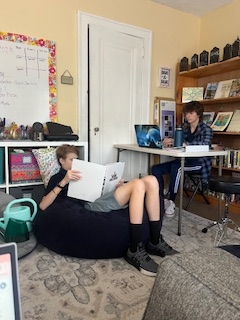Studio 2 & 3 – Grades 9-12
developing global citizens
Goals of Studio 2 & 3
In Studio 2 the younger adolescent is focused on Valorization. Valorization of the adolescent’s personality is central to their academic and social/emotional development. Valorization is the focus of the early adolescent and is found through authentic work experiences. The Montessori secondary curriculum includes opportunities for valorization through innovation, independence, financial literacy, service learning, and developing real world skills. Providing real life experiences gives the adolescent learner the validity they require to grow into who they wish to be in the world and aids them in the development of their cosmic task. Through the valorization of their personality, they are growing into global citizens in practice, not just in theory.
In Studio 3 the older adolescent is focused on developing their Cosmic Task. While the Younger adolescent is busy experimenting, taking risks, socializing, and exploring real world experiences, the older adolescent is busy figuring out where they fit in the community and world as a human being. The older adolescent is determining who they want to be and what impact they wish to have on their world. This is what Montessori referred to as their “Cosmic Task.” We seek to provide older adolescents with a safe place to explore this part of their development and to help them figure out how they will become global citizens.
Structures of Inquiry
When we think about Montessori, we think about a classroom that supports independent work with instruction given to learners by the Guides. Guides give “lessons” on how to manipulate the hands-on work found in the classroom through a 3-period lesson. The Montessori Secondary classroom contains all of these same features, just composed differently. The Secondary classroom uses Inquiry and Project Based learning, supporting the learners to develop independence and make their thinking visible!
The “materials” in the Secondary classroom are the Study Guides. Study Guides act as a structure for inquiry within the classroom providing the learner with a schedule for lessons, follow up assignments, and innovation projects to demonstrate their knowledge. Here is an example of a Study Guide used in a Secondary classroom.
Erdkinder
Maria Montessori offered directives for the education of Adolescents in three appendices written at the end of her work “From Childhood to Adolescence.”
Through these writings and others, we learn that Montessori had a unique understanding of the needs of Adolescents and that a crucial part of the education of the 12-18 year old comes in the Erdkinder.
Erdkinder fundamentally means “children of the land,” and it is comprised of the work of the hand, heart, and mind as demonstrated through:
- The Farm ~ in our community, this is found in Maker’s Space
- Microeconomy ~ offers real life experience and knowledge toward financial independence
- Service Learning ~ learners have valid experiences as part of the larger community
- Field Experiences ~ real life experiences to bring validity to their work
Curriculum Information
Mathematics involves critical thinking and problem solving skills while following a traditional journey from Algebra 1 to Calculus. Mathematics Flowchart.
Language Arts students are required to take 4 credits of English Language Arts with a focus on literature analysis and writing skills. Students take ELA 1 & 2 on campus with an option for Dual Enrollment or campus based learning for ELA 3 & 4.
Scientific studies students are required to complete 3 credits of Science including Physical Science, Biology, and Chemistry. Additional classes may be offered through Dual Enrollment and FLVS.
Humanities students are required to complete 4 credits of Humanities on campus with a focus on our school’s cultural curriculum including World History, US History, European History, Human Geography, Ancient Civilizations, Early Man, and more.
Technology is incorporated on a variety of levels with students using their personal computers.
World Languages our learners are developing Global Citizenship and are required to take 4 years of a World Language with 2 years being consecutive of the same language (ex. Spanish 1 & Spanish 2). World Language courses will be offered through FLVS.
Electives students are required to complete 5 credit hours of electives. Electives are opportunities for learners to explore areas of interest. Curriculums will be designed for independent study by the guides.
Learners familiar with the structures of inquiry can design their curriculum with the help of the guides. The opportunities are endless. Some examples of available Electives are Driver’s Education, Steal Like an Artist, Journey To Freedom, History of the Stoics, The Art of Animal Science, The Designer in You, Creative Writing, YA Book Study, The Math of Quilting, etc.





